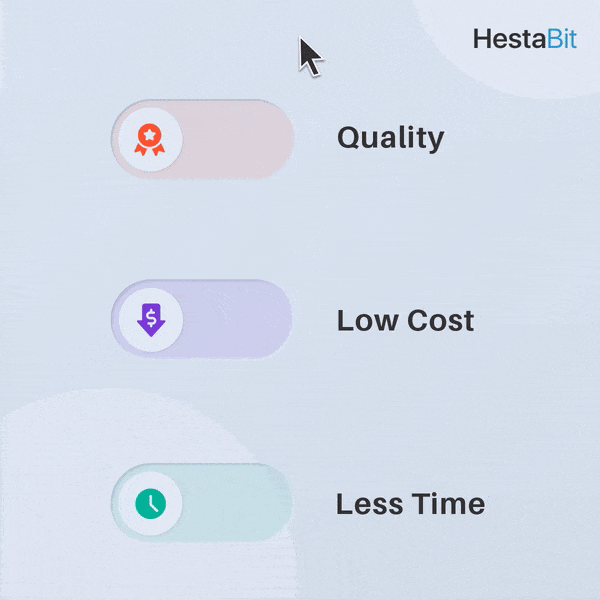Oh, how good it would be if a product owner had a surplus budget and unlimited time to deliver a high-quality product. Wouldn’t it be just amazing?
Of course, it will be, but unfortunately, that’s a remote possibility for a product owner.
A product owner has to give detailed attention to every aspect of development; they have way too many constraints when it comes to developing the product. It doesn’t matter if you are a budding entrepreneur or already established; everyone has to face these constraints.
However, as the managing partner of the Pabrai Investment funds, a firm with net worth of over $100 million, Mr. Mohnish Pabrai said:
“Entrepreneurs Are Great At Dealing With Uncertainty And Also Very Good At Minimizing Risk. That’s The Classic Entrepreneur.”
An entrepreneur must keep in mind the three constraints — scope, time, and cost in order to minimize risk and deal with uncertainty better.

These are something almost all product owners have worked on but may not have given too much thought to. However, in project management, these three are very crucial and must be given proper consideration.
Scope, time, and cost together make the Quality triangle, popularly known as project management triangle.
In this article, we will try to give a comprehensive view of the Quality triangle.
We would cover:
- Introduction to project management triangle.
- Explained: Time, Cost, Scope.
- Advantages of using the quality triangle.
WHAT IS THE QUALITY TRIANGLE?

The quality triangle is also referred to as the project management triangle, iron triangle, project triangle, triple constraint, and scope triangle.
So, if next time someone mentions any of them, don’t get confused, they are all the same.
This concept has been used to communicate the convolutions of a project since the 1950s, so it’s not at all new.
The triangle indicates that all three constraints, namely, time, scope (also known as quality), and cost are all interconnected, and change in one can affect the other two.
For example, if you wish to increase the quality of your project by, say, adding some more features, it is apparent that you will have to increase your budget and may also have to push back the deadline of product launch.
Or maybe, if your project doesn’t allow you to push back deadlines, you may have to descope by possibly creating a basic prototype or increase the expenditure.
All I am trying to say is, it’s all interconnected; hence, the project manager must carefully observe and then decide which compromises make the most sense for his project.
LET’S LOOK AT THE QUALITY TRIANGLE CLOSELY:
Since all the three constraints are interrelated and any change in one will perpetually affect the other two, a product owner needs to ensure that each constraint is appropriately managed. A slight deviation in a plan can primarily affect the project’s growth.
To do that, it is crucial to know the intricacies of the quality triangle, which is why we will explain each constraint and best practices the project manager can use to manage their project better.
TIME:

Time is a very crucial factor to focus on while developing your project.
Every project manager knows how important it is to predict the right time.
However, it’s easier said than done.
Following factors can help project owners to overcome time constraints.
Some challenges every product manager must be aware of are:
- Overoptimism:
It is good to be optimistic. But it’s even better to be smart. While it is good that you trust your team’s capabilities, it is a must to evaluate past projects, each team member’s workload, and current factors that may affect project delivery.
To overcome this challenge you must examine each element and prepare a schedule that reflects reality.
- Delay by external factors:
If your project is dependent on an external factor like a supplier who supplies equipment for your project development, there could be chances that your project may get delayed if there’s a delay by the other end.
To avoid such situations maintaining communications with the supplier is a must. Make sure they don’t overlook the necessary delivery time and dates.
- Insufficient use of Human Resources:
Some tasks run in a sequence, which means one job can not be started until the previous one is over. This can cause a significant delay in the production process. Suppose one team is completing their part while the other one is merely sitting and waiting, contributing nothing at that point in time. In such cases, you are not only wasting time but a lot of money too.
To counter the situation, it is essential to monitor dependencies closely and assign tasks keeping it in mind so that every department is working on the product simultaneously.
- Inconsistency in staffing:
There are many reasons that can contribute to creating inconsistency among your employees. However, there are mainly two reasons increasing the chances of this happening:
- Your developers may be a novice: Things will obviously be easier when you have a team of experienced and highly skilled developers, however if you are working with developers who are new to the field then developing a project may not be a cakewalk for you. If your developers are less experienced in the required technology and skills then you would have to put in greater efforts to make things work according to you.
To counter this situation, try to give some extra time to your developers to get acquainted with the technology, provide training on the required skills, if possible. You can also create a proof of concept project for them to enhance their skills, before they start working on the actual project.
- Uneven distribution of work: How a product manager distributes the task among the teammates put a huge impact on employee consistency. If the manager creates tasks with very minimum or no knowledge of the team members everyday work, then s/he may unintentionally burden the employees with overwork. If the project manager creates bigger tasks, not keeping in account the everyday work of the employees, then this could result in delay of the project.
To avoid exposing your project to such a situation, try dividing the project into smaller parts, preferably one task should not be stretched to the next day. This way you would be able to monitor the daily tasks performed and your project would be gradually developing everyday. Using this strategy you can also manipulate the delivery time efficiently.
- Staff Motivation:
Abating enthusiasm or increasing absenteeism due to overwork among the employees could be a major reason for the delay in your product growth. Issues like these must be sorted out as soon as possible.
Forget about right now; issues like these can hamper your company’s growth in the long run too.
Make sure you keep your employees motivated, distribute tasks evenly, and your employees must know how important their contribution to the work is.
Communication must always be encouraged.
A minor delay in the project development can directly affect the revenue and can put a negative mark on the organization’s reputation. Hence, it is crucial to focus on this constraint.
COST:

The budget is the biggest constraint of all.
Every product owner has to set a structured budget to develop his product. But sometimes projects going over budget is unavoidable.
No matter how hard you try or plan using all available tools, the project may still get over budget.
However, projects going over budget are never feasible for any product owner and should not happen very frequently. Once a project goes over budget, it is very inconvenient to bring it back to the budget. Hence, prevention is the best remedy.
Some factors to focus on, for avoiding such situations:
- Mistakes in cost estimates:
This can happen when budget estimates are very too optimistic. When there’s inaccuracy in calculating the budget estimates or the budget fails to include possible paucities, or maybe the work was assigned to a less qualified person whose work may have to be revised.
- Loose budget tracking:
It is very important to create a detailed and thorough budget in the planning stage, but a detailed budget consists of more than just monetary records.
The project manager must give close attention to every detail that can bring a change into the prepared budget. Every team activity must be tracked in the budget when the work starts. From how many hours did the team spend on the project to tracking the resources used by the team, everything must be taken into account.
The project manager must make sure that the responsibilities are shared equally among the team members. The member given with a certain responsibility must be accountable for it.
By effectively applying such strategies to your budget, you can minimize the expenditures and maximize the output, within the set time frame.
- Outsourcing cost:
There may be instances when a product owner may have to hire temporary staff to build the project faster.
However, the most important factor to keep in mind before hiring a developer is to be visionary. The product manager must take actions in the present with long term goals in mind. As in, hiring a less experienced developer currently may look more appealing to the project manager since you can pay her/him less.
But it is to be remembered that constant monitoring and corrections must be in check while working with a novice developer. If close monitoring at each phase is compromised even a bit, the project owner can end up putting in more time and cost.
- Project delays:
Delay in your current project can put a huge cost burden onto a product owner. The longer the project takes to develop, the longer you will need to pay your staff and for the resources.
To avoid such situations small tasks must be broken down and distributed among the employees evenly. These tasks must be monitored and taken into account on a daily basis to ensure that everything is going as planned.
If daily reporting is taken care of, there is low risk of exposing your project to future delays.
SCOPE:
Okay, suppose your team is all set with the project, ready to unleash the market, and just at the last moment, your stakeholder asks you to add a few things in the project.
Well, it is okay until they are just a few things, but sometimes this may get out of control and end up increasing the expenditure or causing a delay in the project deadline.
To avoid the hassle, there are some common challenges a product owner must be aware of:
- Requesting additional features:
Suppose a team member comes up with a feature; s/he thinks will surely benefit the project. In such cases, a project manager must not allow the team to shift focus from the primary goal, just to add a feature.
If the budget can allow the scope change, then the manager may go ahead with the feature addition. If not, new additions must not be included.
- Obscure requirements:
Even the clearly defined projects sometimes suffer scope creep, then you can only imagine what could be the consequences of carelessly planned projects.
Without detailed project analysis and precise decomposition of the project, scope creep can happen due to misinterpretations.
- Last-minute changes:
If project requirements are loosely defined, your project would be open to scope creep.
If you implement any last-minute changes that were not originally decided, it may lead the project to a different path and would most likely affect both the budget and the schedule.
Document each step and ask your team to sign off on them, to avoid any future hassle.
- Internal factors:
A product owner might not be able to change external factors like the market or competition. But internal factors like stakeholders asking for last-minute changes must be addressed, keeping the project needs in mind.
At such times the product manager must come up with the pros and cons of the last-minute change. Since it could largely affect product delivery and budget.
ADVANTAGES OF USING THE QUALITY TRIANGLE WHILE DEVELOPING YOUR PRODUCT:
The quality triangle is an essential part of a product owner’s toolbox. It guides the owner in day to day tasks and helps them discover the project’s limitations.
- Adapting to changing conditions:
Change is the biggest constant in the project development process.
The quality triangle helps the owner to determine that a product can not be cheap, high quality, and quickly delivered all at once.
Hence, the product owner must know where to make adjustments and compromises.
- Communicating constraints made easy:
The project management triangle had made it easier for the owner to communicate the constraints with the clients more efficiently and comfortably.
Projects mostly fail because of poor communication.
Hence it is vital to communicate the project’s needs to your team as well as the stakeholders.
A quality triangle is a visual tool through which you can illustrate the correlation between the three constraints, and make the stakeholders and your teammates understand the outcomes of their demands.
Parting thoughts:
The quality triangle allows you to control the other two factors if one is going haywire. You can simply adjust the other two if one goes over the estimated plan.
However, it is only realistic to realize that you can master just the two, for example:
Take it as High-Quality, In-Budget, and Quick.
Now it is realistic to think that you’ll be able to deliver a high-quality product quickly. However, the budget would be compromised.
Or,
You can deliver a quick and in-budget project, but the quality will be compromised.
So, in a way, one factor is inversely proportional to the other two.
Therefore, if one goes out of hand, it is possible to manage the other two to be on track.
The quality triangle is a must-know for every product owner to understand better the need for his product and the outcome of changes he puts at the current moment.




